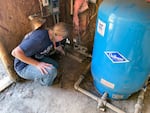Morrow County declared a local state of emergency on Thursday after private well testing showed high levels of nitrate contamination.
During a special meeting, Morrow County Commissioners voted 3-0 in favor of the measure, which will allow the county to take immediate action to protect drinking water. It’s the first time an Oregon county has declared a state of emergency because of water quality issues.
The county will start distributing bottled water in the next few days and will be setting up water distribution trailers in Boardman so residents can fill large containers.

Silvia Hernandez's private well in the outskirts of Boardman, Oregon on April 15, 2022
Monica Samayoa, Monica Samayoa / OPB
Groundwater is the primary drinking source for Morrow County residents. But that groundwater has been plagued by high levels of nitrates.
The state designated Morrow and Umatilla counties as groundwater management areas more than 30 years ago. A committee was formed to address the issue and identify activities that contribute to the contamination.
But state data shows the nitrate problem has only gotten worse.
“It’s been an ongoing issue,” Morrow County Commissioner Chair Jim Doherty said. “It’s not something that just hit us in the last week, and we’ve been approaching it from lots of different angles.”
Drinking high levels of nitrate can lead to respiratory infections, thyroid dysfunction and stomach or bladder cancer. It can also cause “blue baby syndrome,” which decreases the blood’s capacity to carry oxygen, especially in infants drinking baby formula mixed with contaminated water. According to the Environmental Protection Agency, nitrate levels exceeding 10 milligrams per liter can cause serious health effects.
Earlier this year, the Oregon Department of Environmental Quality fined the Port of Morrow $1.3 million for overapplying 165 tons of nitrogen-rich wastewater onto agricultural fields over a four-year period and failing to monitor the nitrate contamination.
The Port of Morrow released a statement on Thursday saying it’s considering millions of dollars in upgrades to reduce pollution and is eager to play a role in finding workable solutions.
Doherty said the fine brought this issue back to light and hopes the declaration will open doors to get funding for more testing in homes. Doherty has been going door-to-door with the local health department to test tap water for residents outside of Boardman’s city limits.
So far, he said they’ve tested about 70 wells that were “high enough to cause some pretty severe health issues.” He also found some households were not aware their drinking water was unsafe.
Paul Gray, Morrow County’s emergency manager, said he is now working with the state to help residents get immediate clean water while planning for long-term solutions.
Gray said he wants to do more testing to identify affected locations and get filters in those homes in the next couple of months. But he said the planning process just started and his immediate concern is to provide clean drinking water and continue to educate the public about health concerns. He said he’s asked the Oregon Health Authority to provide a bilingual public information officer to reach Spanish speakers.
A team from Oregon Rural Action is assisting the county and has tested tap water in about 60 homes in Boardman and Irrigon. The team found almost all were above the federal safe drinking water limit and dozens were five times that limit, said Kristin Anderson Ostrom, the group’s executive director. Some residents were unaware of the health effects of drinking high levels of nitrate, and most were using the tap water to wash clothes, take showers and for cooking.
Zaira Sanchez, ORA’s director of organizing, said it was hard to deliver test results.
“The common response from the community was immediate shock and concern,” she said. “For example, one family had a result of 41 milligrams per liter in their water and I asked, ‘what do you think when you see that number or hear that number?’ And the common response was something like, ‘is that high, is that bad?’”
Sanchez said some families attempt to boil their water, but that could worsen the problem. She added some families are already spending up to $100 a month purchasing bottled water.

Annie Philpott says her families private well needs to be replaced but do not have the money to replace it. The Philpott's were hoping to refinancr their home but did not qualify after their well system tested too high for nitrates.
Monica Samayoa / OPB
ORA board member and former DEQ administrator Mitch Wolgamott, who has been working with Anderson Ostrom and Sanchez, said this is the first-time elected officials have stepped up and highlighted this issue. But he said the response doesn’t go far enough.
“That’s addressing the symptoms, that doesn’t really address the cause of the problem,” he said. “And ultimately that’s what’s going to have to happen, is we’re going to have to figure out how to either be putting less nitrogen on the ground or we’re spreading it out a lot more.”
The Oregon Office of Emergency Management is coordinating with Morrow County to meet emergency needs of residents. OEM officials said the emergency declaration does not grant immediate access to state funds or other resources but does allow the county to implement its own emergency procedures. It also prioritizes the need to address the public health emergency without superseding the work of the Lower Umatilla Basin Groundwater Management committee.


